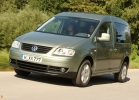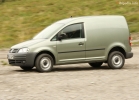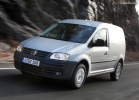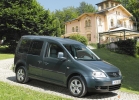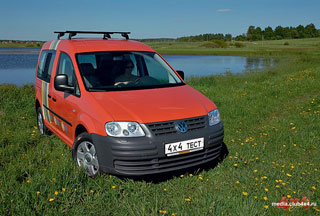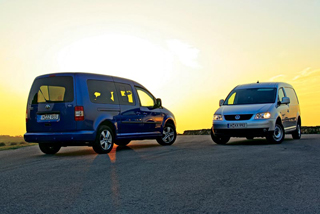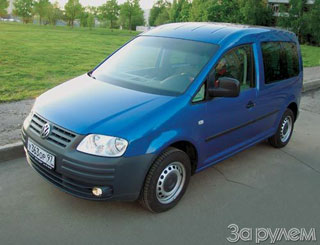Volkswagen Caddy test drive since 2005 Minivan
Volkswagen Caddy: New Heel style
 For the one who looks after a family compactway, a cargo -passenger heel is also an option. You get a slightly more spacious body for the same money, and many Russians have already appreciated it. Volkswagen Caddy Life, Fiat Doblo Panorama and Peugeot Partner Tepee are even better for us than, for example, Volkswagen Touran, Mazda 5 and Renault Scenic. Its creators say about the new generation of the Volkswagen model: next year it will become the best -selling heel in Europe. What are the chances of the novelty to bypass his predecessor, who did not rise above the second or third place in popularity, appreciated by the correspondent of [email protected], who tested the pre-production copies of the new VW Caddy in the suburbs of Frankfurt.
For the one who looks after a family compactway, a cargo -passenger heel is also an option. You get a slightly more spacious body for the same money, and many Russians have already appreciated it. Volkswagen Caddy Life, Fiat Doblo Panorama and Peugeot Partner Tepee are even better for us than, for example, Volkswagen Touran, Mazda 5 and Renault Scenic. Its creators say about the new generation of the Volkswagen model: next year it will become the best -selling heel in Europe. What are the chances of the novelty to bypass his predecessor, who did not rise above the second or third place in popularity, appreciated by the correspondent of [email protected], who tested the pre-production copies of the new VW Caddy in the suburbs of Frankfurt. The car manufacturers, it seems, have not yet figured out what exactly the modifications of heels are needed by Russian customers. Some brands supply us with exclusively primitive and low -power versions with poor equipment, while others offer such a luxury as a glass roof. Many companies do not sell diesel machines in Russia, although it is precisely the traction motors operating on heavy fuel that are best suited to cargo -passenger models. There are extremely few options with automatic. But Volkswagen in this regard stands apart. The previous generation of Caddy in the Russian market had a wide range of engines, a DSG robot, and an all -wheel drive modification, and even an exotic tourist version of the Tramper with a built -in double bed and a kind of tent spreading out of the back door. For the novelty, no less variations are prepared.
Before you go to the underground garage by a car, I should go to the reception where the keys are given, and decide which of the couple dozens of cars prepared for the test I will take. Usually at such a moment you only think about choosing a motor and, possibly, body color (successful for photography), but everything was not so familiar here. The Volkswagenovites themselves argue that if you take into account all the possible combinations of the bodies, engines and options, you can count about a million (!) Different versions of Caddy. In fact, everything, of course, is somewhat simpler. Here is the main thing that you need to know when choosing a German heel: the car can be long-standing or short-minded, and one and the other body have two- (van), five- and even seven-seater modification. But we are primarily interested in Caddy not as commercial, but as family transport. And therefore, for starters, I take a long-drawn seven-seater version with a new 1.2 TSI gasoline engine, which replaced 1.4- and 1.6-liter atmospheres.
What else is new? The previous generation of Volkswagen Caddy has been produced since 2003, and the novelty, in fact, is its evolutionary continuation. You can call the current version a new generation, or you can deep restyling. Everything as with the new Turan that we tested this summer. Creating the next Caddy generation, the Germans took the old body and chassis, redrawn the design of the face in the spirit of all fresh Volkswagenes, refreshed the interior, revised the engines line and made the equipment richer. However, the wealth here with an admixture of purely utilitarian and even frankly simple decisions.
Sitting in the salon of well-equipped modification, I first pay attention to a multimedia system with a touch screen, a leather multifunctional steering wheel, a climate control unit and unexpectedly hard plastic. Cargo genes make themselves felt. The car was originally created not as a passenger, but as commercial transport, and in some ways it is extremely ascetic. Pay attention to the unpainted bumper. And at the same time, Caddy now has ESP in the initial configuration.
Something Caddy frankly loses to compactives. Modern single -combatants amaze with many successful solutions for the whole family: the second row usually consists of three separately adjustable seats, there are leaning tables in the backs of the front seats. Caddy does not have all this. When you look around the interior, the gaze rests against the mezzanine over the heads of the front riders. It is easy to imagine how the driver puts a pack of consumer invoices on it with a familiar movement of the hand

Comfortable pockets with four cup holders and four recesses for 2-liter bottles are placed on the sides of the rear sofa. Under the ceiling, mesh pockets. The same in the middle row. And most of all different departments for trifles in the front of the cabin. At the disposal of the driver and front passenger, drawers under the seats, as well as the shelf above the heads and, of course, boxes in the armrest and front panel
I have 300 km ahead of German autobahns and a secondary highway. Enough to understand the habits of the car and what is even more important to assess the heel to try yourself as a passenger on each of the three rows of seats. The first thing you pay attention to in the cabin is, of course, scope. Where are the compactwecs! In the first and second rows, the supply of space above the head, one might say, is redundant. Yes, and on a traditionally problematic third row, even adult passengers will not support their heads with their heads. However, the riders above 180 cm will be uncomfortable here for another reason, there is no sufficient foot space. That is, with the role of a corporate minibus for seven adults, Caddy will cope only with certain reservations. But as a family car, it will be very good.
By the way, the 47 cm stretched by Maxi differs from the standard Caddy not only the open spaces for the riders, but also the enlarged luggage compartment. At the basic Caddy with a seven -seater salon, the back of the third row almost rests on the fifth door, and Maxi has a place for several bags. However, for transporting a really voluminous lobby of the seat, of course, it is better to remove. And here is the innovation that appeared in the fresh Caddy: the second row is now also made removable. Thus, the family Caddy, if necessary, can be turned into a double car, having received all the advantages of the truck. The luggage compartment volume increases to 3 030 liters in a short -term version and up to 3 880 liters in the case of MAXI modification. Carrying capacity up to 728 kg (depending on the motor).
The gas is constantly on the floor, I try to switch later to hold the motor at high speeds. No, I did not move to Golf GTI for the dose of adrenaline. I'm driving Caddy with a 1.2 TSI motor. The new engine makes you master driving techniques that somewhat resembling a sports style. And this is only to confidently stay in the dynamic city stream. Moreover, I got a more powerful modification of a gasoline engine that develops 105 hp. (The base gives 86 forces). As soon as I release the gas a little, the hint lights up on the dashboard, they say, go to the next program for the sake of saving fuel. If you follow this recommendation, then the thrust is enough only to maintain constant speed, but if necessary, press the gas and no reaction a little to accelerate. It is necessary to instantly smell the reduced. But in the car there are only two people and a couple of not heavy backpacks at all. Frankly, I even began to creep in doubts: can this Caddy go normally with full load? Check.
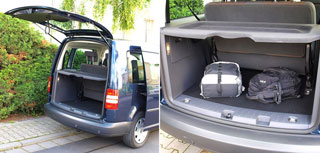 At an intermediate stop, where, according to the organizers, journalists can exchange cars to try out various Caddy modifications, I am in no hurry to give the key. First, I ask six colleagues to ride a couple of blocks with me. From journalists, who also went on the first part of the journey on a 1.2-liter modification, the most skeptical assumptions regarding the results of this experiment sounded. What was universal surprise when Caddy, as before, strainedly, but still confidently began to gain move. The difference is not so great! According to subjective sensations, the dynamics deteriorated no more than when the air conditioner is turned on. The explanation lies in the fact that the 1.2 TFSI motor is distinguished by a good torque: a flat shelf in 175 Nm is a decent indicator comparable to atmosphericians with a volume of 1.8-2 liters.
At an intermediate stop, where, according to the organizers, journalists can exchange cars to try out various Caddy modifications, I am in no hurry to give the key. First, I ask six colleagues to ride a couple of blocks with me. From journalists, who also went on the first part of the journey on a 1.2-liter modification, the most skeptical assumptions regarding the results of this experiment sounded. What was universal surprise when Caddy, as before, strainedly, but still confidently began to gain move. The difference is not so great! According to subjective sensations, the dynamics deteriorated no more than when the air conditioner is turned on. The explanation lies in the fact that the 1.2 TFSI motor is distinguished by a good torque: a flat shelf in 175 Nm is a decent indicator comparable to atmosphericians with a volume of 1.8-2 liters. Nevertheless, returning to the parking lot, I without regrets gave the key to gasoline modification and moved to diesel. This time I got a short -term Caddy with a 1.6 TDI engine. A completely different thing! It is impossible to believe that he is even 3 hp. Weaker than the tested gasoline version, but it is much more comfortable to drive a machine with it. An impressive traction of 250 Nm the engine develops already at 1,500 rpm. According to passport data, acceleration up to 100 km/h in the diesel version occupies 12.9 s, which is 0.2 C worse than 1.2 TSI, but it is much more convenient to control with the 1.6 TDI engine.
Before meeting Caddy, I had some doubts about whether it was possible to put it on a par with compactives, given that the heel had such a cargo rudiment as a spring rear suspension. This solution has not been used on cars for a long time, since such a chassis provides not better smoothness and mediocre handling. In fact, the car was quite obedient on the road. In the rear places, it shakes a little stronger than on the front. But most drivers may not notice fundamental differences in the work of the chassis compared to the usual spring suspension.
In addition to the two modifications I tested, Caddy also has three new engines: 1.2 TSI (86 hp), 1.6 TDI (75 hp) and 2.0 TDI (110 hp). From the previous generation, the novelty inherited only one top -top 2.0 TDI motor with a capacity of 140 hp. From any of the diesel modifications for the surcharge, you can get a DSG robot, and gasoline motors are aggregated only with mechanics. A full-wheel drive transmission is only with a 110-horsepower diesel engine (not provided for it).
Russian sales of the new Volkswagen Caddy will start in October-November. Prices have not yet been announced, but, according to the Germans, the car in Europe will practically not rise in price in Europe. If Volkswagen retains this policy with us, then we can expect that the basic version will cost a little less than 800,000 rubles.






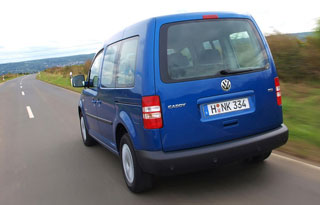



Pavel Elshin
Photo by the author and company Volkswagen
Competitors
Peugeot Partner Tepee
The French heel last year escaped to the leaders of the Russian market in its class. Two modifications to choose from: with a 1.6-liter gasoline engine developing 90 hp. (from 618,000 rubles), and with a diesel engine of a similar volume and power (surcharge 92,000 rubles). Transmission only mechanics. The highlight of the equipment should be recognized as a glass roof Zenith, consisting of four separate windows. Maximum trunk volume 2 800 liters
Fiat Doblo Panorama
This is one of the most affordable models in the class (from 521,300 rubles), since the car is assembled at the Sollers factory in Naberezhnye Chelny. Due to its accessibility, the Italian has been on the list of class bestsellers for more than one year. Although Doblo Panorama is produced in us only in the youngest modification with a 1.4 -liter engine (77 hp) and mechanics, even with it the machine differs an impressive carrying capacity of 730 kg. Maximum trunk volume 3,000 liters
Ford Tourneo Connect
Buyers of this model, as in the case of Volkswagen, can choose between standard and elongated bodies. Moreover, the long -border modification also has an increased roof (14.4 cm above Caddy). A choice of five or eight seats (all other competitors are five -seater). In the range of engines there are three versions of a 1.8-liter diesel with a capacity of 75, 90 and 110 hp. Transmission only 6-speed mechanics. Unfortunately, even taking into account the discounts currently current, Tourneo Connect is expensive: from 884,000 rubles. For the least powerful short -drawn version up to 1,110,000 rubles. For elongated with a top motor. The maximum trunk volume is 3,400 liters (in a long -drawn version). Carrying capacity 599-739 kg, depending on the modification
Citroen Berlingo
Now in Russia, both the new generation of Berlingo of 2008 is sold, and the cheaper previous generation (such models have the FIRST prefix in their name). An alternative to the new Volkswagen, of course, should be considered a more fresh Frenchman standing from 538,000 rubles. For a version with a 1.6-liter gasoline engine developing 90 hp. (carrying capacity 628 kg). Forced up to 110 hp Version for 59,000 rubles. more expensive (its carrying capacity of 598 kg). The maximum volume of the luggage compartment is 3,000 liters. Citroen Berlingo First is equipped with only a 1.4-liter engine (75 hp) and costs noticeably cheaper than all competitors from 434,000 rubles
Renault Kangoo Passenger
The current generation of Renault Kangoo, which debuted two years ago, is somewhat more suitable for family operation than Caddy. There are folding tables, and on the ceiling above the second row of seats, large closing boxes, which the renoshniki themselves call the clothing department of the aviation type. But the motor, unfortunately, is only one 1.6-liter, gasoline (84 hp), and the box only mechanics. The Frenchman is distinguished by the smallest trunk: the maximum volume is 1,521 liters. Price from 580,000 rubles
Source: Auto.mail.ru
VOLKSWAGEN CADDY Video Drive Video since 2005
VOLKSWAGEN CADDY Crash Video since 2005
Volkswagen Caddy test drives since 2005
Volkswagen Caddy crash test since 2005
Krassh Test: Detailed Information27%
Driver and passengers
13%
Pedestrians
30%
Children-passengers
Volkswagen Caddy malfunctions since 2005
Volkswagen Caddy malfunctions: Detailed information| Caddy since 2005 | |
|---|---|
| Engine |  |
| Transmission |  |
| Control system and suspension |  |
| Brake system |  |
| Air heating and air conditioning |  |
| Launch and charging system |  |
| Electric components and so on |  |
| Corrosion body stability |  |

